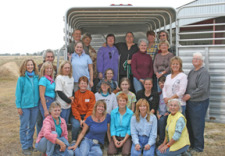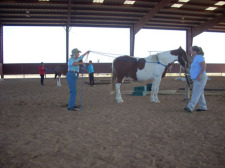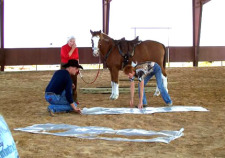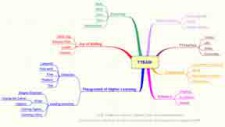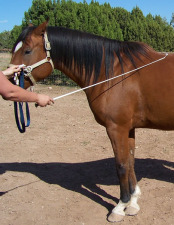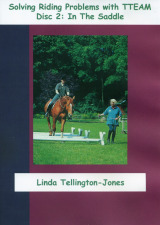Search Results
Your search for tteam returned 4 categories and 46 items
Pages
- Our Method for > Horses > Links
- About Us > Our Teachers > Meet Linda
- Worldwide > Contact Us
- About Us > Our Teachers > Meet Linda > From Linda's Desk > Animal Hospice and Conscious Euthanasia
Items
About Us > Our Teachers > Meet Our Instructors
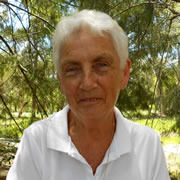
Andy Robertson
Tellington TTouch® Instructor for Companion Animals, Andy incorporates her skills as a Motivational Dog Trainer and Feldenkrais practitioner in her teaching.
In the late 1980's Andy attended an evening demonstration of TTEAM® , the original name for the Tellington TTouch® Method. The TT® ouch presenter did not touch a person or an animal, but had participants pair up and gave direction from the floor. At that stage. Andy was ready for a change as she was uncomfortable with the way most others were training dogs and the Tellingon Method just felt right. Changing how Andy touched her own dog has benefited all the other animals that she has come in contact with from that day forward.
As a Motivational Trainer, Andy uses the Tellington TTouch® Method when she teaches Puppy classes as well as Teen and Adult classes. Andy teaches workshops and one-on-one sessions. While Andy mainly works with dogs, she is interested in working with other species and has had occasion to work with wildlife.
Andy's special interest is with animals that lack basic social skills needed to live in society as these animals can be reactive to many issues. The owners/partners find it very interesting how TTouch® , Ground Work and use of TTouch® Equipment can make changes that affect both the animals and themselves.
Andy lives just outside of Sydney, NSW, Australia. Contact her: ttouch@hbi.com.au
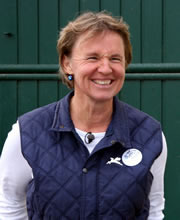
Bibi Degn
Bibi was awarded the Tellington TTouch® Instructor level for dogs and horses in 2002. Bibi's unique contribution has been the creation and development of the Angie program (the Tellington Method for children and youth). Her special interests include teaching the Angie courses and spreading the Tellington Method as a therapeutic and educational system for youth. She is also interested in the importance of the work under saddle in the training to become a TTouch® practitioner for horses. Elements from Connected Riding and many years of close work with Peggy Cummings have contributed to it.
Bibi was born and raised in Austria. Her involvement with and dedication to animals began early on. Colonel Neufellner was her riding instructor in her childhood. Bibi earned the Bronze Reitabzeichen at the State Stallion Stable Paura. She participated at western trainings with Jean Claude Dysli. Her other accomplishments in the equine world include: she is a trail ride leader; she participated actively and successfully at several fox hunts and long distance races, and won and placed second at several long distance races both on the national and international levels.
Bibi earned a degree in studies Pedagogic as a elementary school teacher and she studied, extensively, veterinary medicine and Psychology without a degree. Bibi also owned/managed a breeding and boarding stable for Arabian horses in Austria and kept the mare book for the Arab breeding club. The dog breed, Magyar viszlas from Hungary, was another specialty of Bibi's. At her farm, she took care of many horses and dogs and other species for many years.
During 1985 and 1986, Bibi stayed in Andalusia, Spain while she learned dressage and established many contacts in the riding style of southern Spain. Here to she participated in long-distance races and long trail rides. 1987 was a banner year for Bibi when she first came in contact with the Tellington TTouch® Method during a long distance ride in the USA. She met the Tellington TTouch® Training Practitioner Tina Hutton with whom she spent many weeks during the following years. Bibi was introduced to Centered Riding and started incorporating this as well as the Tellington Method to her training. Bibi participated in many TTouch® Trainings, mainly with Linda Tellington-Jones in Germany and in the USA.
In 1996 Bibi took over the TTouch Gilde Office in Germany and continues to manage it. She organizes the Practitioner training programs for dogs and horses in Germany and she teaches many courses for dogs and horses.
Today Bibi Degn lives in Neunkirchen-Seelscheid, Germany and she is working to found a Educational Academy for humans and animals with the Tellington TTouch® Method and Animal Ambassadors® as their focal point. Email Bibi bibi@tteam.de or visit the Gilde
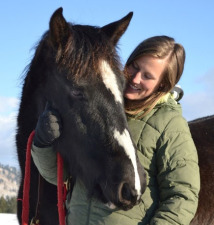
Mandy Pretty
Born and raised with horses, Mandy was literally riding before she could walk. Her exposure to the horse world was somewhat unconventional. Daughter of clinician Robyn Hood, and niece of Internationally renowned horse woman Linda Tellington-Jones, meant that her norm for handling and interacting with horses was several decades ahead of its time. Long before equine chiropractors, massage therapists and acupuncturists were main stream, Mandy and her family were looking for tangible physical and emotional reasons for unwanted behavior. They began phasing out black and white behavioral labels like “stubborn,” “lazy” and “disrespectful.” In Mandy's family, horse behavior was viewed as reaction to a concrete catalyst, requiring looking at balance, pain, fear, fear of pain and issues of rider communication.
At the age of 4 and a half, on the way to her first Advanced TTEAM® (now Tellington TTouch®) Training in Boulder, Colorado, Mandy first met Peggy Cummings, the founder of Connected Riding.
For over a decade Mandy was schooled in Centered Riding and influenced by top Icelandic riders and clinicians. She was immersed in the world of horses, helping to start youngsters, exercise sales horses as well as participating in demonstrations and competitions with some of her parents' Icelandic horses.
Then, at age 17 Mandy met Peggy Cummings again. Although initially skeptical of Peggy's Connected Riding® concepts, Mandy soon understood the influence of posture and its effect on the horse underneath. The proof was in the pudding as it were, and she was soon a “convert” to Connected Riding®. Peggy became Mandy's mentor and riding coach, expanding her knowledge of equine/rider bio-mechanics and ideal function under saddle with Connected Riding.
Mandy trains and teaches all breeds and disciplines full time; incorporating the Tellington TTouch® Method-Connect to train young horses and re-school older horses alike. In addition to training at Icelandic Horse Farm, Mandy travels to teach clinics featuring the Tellington TTouch® Method and Connected Riding. Mandy has taught independently in Mexico, Australia, the US and several Canadian provinces as well as assisting Robyn throughout Europe, South Africa, Australia and North America.
Mandy creates a positive experience for horse and rider; improving performance without compromising physical, emotional or mental well being. Her clinics easily apply to an all breed format although often geared toward the Icelandic Horse. Mandy teaches one to five-day workshops throughout the year, offering several at The Icelandic Horse Farm. She is available for demonstrations, riding lessons, lectures and clinics.
Mandy is a Tellington TTouch® Equine Instructor and a Certified Connected Riding Practitioner. She lives near Vernon, BC down the road from Robyn and Phil (aka Grandma & Grandpa) with her husband Walt and two young sons on their "Faux Farm." Visit her own website: www.intouchwithyourhorse.com.
About Us > Research & Studies
Horse 1985 Stress Reduction Study
Study of the Effects of TTouch® for Reduction of Stress
Bitsa Olympic Center, Moscow, Russia
In a TTEAM and TTouch® 13 day training, 8 Veterinarians, along with riders and trainers participated in a study to measure levels of stress hormones and benefits of TTEAM for sport horses. Twenty horses were included in the study. All of them were worked daily in dressage or jumping training and all 20 had daily blood samples drawn to check the level of stress hormones. Ten horses were TTouched and TTEAMed daily by the course participants, and the other ten were not. The results showed significantly lower levels of stress hormones in the TTEAMed horses.
The following letter is a translation from the Director of the Moscow Soviet Professional Unions Horse-Sport Complex and head veterinarian, Dr. Nina Khanzhina, regarding the study. Conducted over a period of 14 days.
L. Tellington-Jones
Esalen Institute
Soviet-American Exchange
From March 28 to April 10, 1985, the veterinarians of the Moscow Horse Center at Bitsa and the sportsmen and trainers of various clubs and representative teams of the USSR, took a practical study course in the teaching of TTEAM method under the direction of L. Tellington-Jones and the method teachers of D. Thompson and L. Will.
At the same time, the Department of Standard Physiology of the K.I. Skryabin Moscow Veterinarian Academy conducted scientific research on the influence of these methods on the presence of stress hormones (adrenaline and nor-adrenaline). In the experimental group of horses, on which the TTEAM method was applied, an improvement was recorded in the stress hormones.
Furthermore, the horses improved in their outward appearance, and their ability to work increased. The veterinarians noticed that the horses became more calm in behavior, that their capability to give medical aid had increased, and that constraint in movement, caused by injuries, trauma, arthritis, etc. had disappeared. It is possible, in applying the TTEAM method, to eliminate unhealthy conditions in the muscular system and contracted tendons. It is also possible to teach the horse to break bad habits and to improve its capacity to work in sport activities. We express our gratitude to the Esalen Institute for the afforded opportunity to conduct practical courses in the TTEAM method. We hope that this collaboration will continue.
V. Akivis, Director KSK
N. Khanzhina, DVM
First Published in the 1985 TTEAM News International Pp. 14-15
The following is a translation of a 1985 letter from Dr. Nina Khanzhina, Head Veterinarian of the Bitsa Sports Complex:
Dear L. Tellington-Jones,
I am extremely grateful for the opportunity to work with you and to study the TTEAM method. Your method for me is absolutely new and very interesting. To apply the TTEAM method to work with horses opens a vast array of possibilities for veterinarians, sportsmen and trainers. After the horse is in a state of relaxation, it is very easy and simple for a veterinarian to apply medical aid. And this same method is healing for many conditions of horses: colic, myosis, etc.
The experimental group of horses, which we used to conduct the exercises according to your method, have had an improvement in general condition and in jumping technique, as well as a disappearance of constraint and unrhythmical movement. I would like to continue working with you and improve my knowledge, as well as to help horses and people find a common language.
N. Khanzhina, DVM
Head Veterinarian
Bitsa Sports Complex
Back Issue of TTEAM News International 1985 Pp. 14-15
NOTE: TTEAM is an acronym of "Tellington TTouch® Equine Awareness Method." Since this article was written, the brand name for all the facets of the TTouch® organization is Tellington TTouch® Training.
Human 2007 Changing the World One TTouch® at a Time
Changing the World One TTouch® at a Time -- Abridged Version
by Robin Bernhard and Sandy Rakowitz
TTouch® has been changing the course of therapeutic healing with animals and people around the world for over thirty years now. This ground-breaking work, developed by pioneer, Linda Tellington-Jones, is being studied by Robin Bernhard, LCSW, a psychotherapist who owns and runs the Virginia Neurofeedback, Attachment and Trauma Center in Charlottesville, Jessica Eure, Med, Ed.S., a new counselor who specializes in neurofeedback with Bernhard at VNATC, and by Sandy Rakowitz, a practitioner of Energy Healing Medicine and TTouch, who owns and runs One Heart Healing Center for People and Animals, also in Charlottesville.
Both Bernhard and Rakowitz have over twenty years of experience in their areas of practice, and together, they are making headway in the use of this specialized touch to help with people who have suffered from brain injuries. Bernhard and Rakowitz would like to see Charlottesville become a center for TTouch research and training. Just last year, they did a study which showed exactly what they and others have been concluding all along - that this specialized work can improve brain function.
The article "Changing the World: One TTouch® at a Time" written by Robin Bernhard and TTEAM Practitioner Sandy Rakowitz, first published in Echo Newspaper, is now published in the new e-book by Laura Bruno, M.A., entitled, If I Only Had a Brain Injury: A TBI Survivor and Life Coach's Guide to Chronic Fatigue, Concussion, Lyme Disease, Migraine or Other "Medical Mystery". This compelling story is also a special resource for Caregivers, Survivors and Treatment Providers. Included in the electronic book is the author’s own inspirational story, 52 Healing Hints, and contributions by 13 other Survivors, Caregivers and Treatment Providers.
Horse 1999 EPM. Neurological Study
Tellington TTouch® as a Complement in the Rehabilitation of Horses with EPM and Neurological Deficits
The manual has been given to several veterinarians for the use of their clients and has been found very effective. Additional study and documentation required.
A study of the rehabilitation of horses with neurological deficits, using TTEAM, started through the efforts of Dr. Mark Meddleton and his wife, Becky. Becky's horse, Jewel, was severely affected by Equine Protozoal Myeloencephalitis (EPM) and Dr. Mark was trying all the forms of experimental medication. During the times that the medication seemed to be working, Becky decided to try TTEAM to rehabilitate Jewel. Becky applied her basic knowledge of TTEAM and was impressed by what she was observing with Jewel.
Becky and Mark came to a TTEAM workshop at Galisteo Creek Farms in April, 1999 to learn more and to talk with Linda to see if TTEAM would cooperate in a study of rehabilitating horses with EPM. Becky explained to the group that initially she had thought that only the ground exercises would help, but after talking with TTEAM Instructor Carol A. Lang, she tried the TTouch and realized it too was a key element.
To initiate the study, Linda and Carol met with Dr. Mark and Becky at a client's farm. A neurological exam was performed by Dr. Mark on three horses. TTEAM techniques were shown the horse's owner and Dr. Mark set up a basic schedule of rehabilitation with instructions the owner was to follow. In a few weeks, Carol met with Dr. Mark and Becky at this client's farm. Dr. Mark reexamined the horses and both he and the owner agreed that improvement had been made. Carol taught the owner more TTEAM techniques and Dr. Mark scheduled another evaluation of the horses.
In June of 1999, Dr. Mark, Becky and Carol worked with Jewel and Mark's horse, Dugan, who also had been diagnosed with EPM. Dr. Mark did a neurological exam of each horse. Then, as they did TTEAM and TTouch® with both horses, Dr. Mark, Becky and Carol discussed which techniques were working, the timing of the sessions, the sequence of TTouch® and the work in the TTEAM Confidence Course. They also made a first draft of a checklist for the owners to keep track of their horses rehabilitation program.
Carol accompanied Dr. Mark and Becky on visits to at least three clients who had horses with neurological difficulties. Each owner was shown TTEAM techniques and Becky recommended the rehabilitative process. Dr. Mark's scheduled follow-up neurological checks in order to track progress. Becky reported that the percentage of improvement of the trial horses was very high and that the owners were very satisfied with the results.
To continue the development of a protocol that Dr. Mark planned to present to the AVMA, Carol met with Dr. Mark and Becky and TTEAM Practitioner, Kirsten Henry several times over the next year. They filmed a video demonstrating how to do TTEAM techniques specifically for rehabilitation of horses with neurological deficits and developed a modified Confidence Course.
They did many trials with TTEAM techniques, in particular the use of wand and lead, the TTEAM body wrap and TTouches.
Carol prepared a booklet of TTEAM techniques to be distributed to participants of the study. Dr. Meddleton reviewed this booklet and made suggestions from his perspective as a veterinarian.
Hoping to receive a grant, Dr. Mark presented this protocol to a veterinary conference in the fall of 2000. The evaluation and advice offered about their study gave Dr. Mark and Becky new insights and direction. However, Dr. Mark's veterinarian practice was expanding so much that their time for continuing this study was curtailed.
In March, 2002 Dr. Mark reported to Carol that he could not proceed with the study of a protocol for EPM/neurologically impaired horses. He offered to share his and Becky's work with any veterinarian that Linda might find who would be interested in continuing.
We know that TTEAM has been very effective in helping horses rehabilitate from neurological deficits. We offer this booklet as a guide to TTEAM Practitioners and others who will use TTEAM and TTouch to facilitate their horses' rehabilitation.
Carol A, Lang, TTouch Instructor
Santa Fe, New Mexico
Purchase the Booklet in our Shop.
NOTE: TTEAM is an acronym of "Tellington TTouch® Equine Awareness Method." Since this article was written, the brand name for all the facets of the TTouch® organization is Tellington TTouch®.
Attendees Log-In > Files for Training
Our Method for > Horses > Success Stories
Older horses
"The TTEAM Newsletter is my “life line” to keep in touch with all the stuff you people get up to. Every now and again there is a surge of interest here in New Zealand, but for me it just keeps on getting better and better. Results mostly happen in minutes for me now, and people are amazed.
"I am always getting asked when I am going to compete my horse even though people cannot believe his age is 24 years old. Tellington Method had done so much for him. He had an accident 12 years ago that left him quite crippled and without the Tellington TTouch method, he would not be with me. He has taught me so much and given me some amazing experiences and may lovely rides.
"Thank you for sharing TTouch with me and many other people too. Animals, worldwide, love what the Tellington TTouch Method brings to them. And never let us forget the great job Robyn has done for so long bringing the written word to all of us TTouch people."
– Coral Boulton in New Zealand
"After seeing Instructor, Edie Jane Eaton’s demonstration, I have been using the Tellington TTouch exercises for two weeks and my l9 year old advanced dressage thoroughbred’s back is definitely more supple. And engagement is becoming elastic. He was stiff, and I have had problems getting him to use his hind-end to engage without getting stiffer in his back. No more!"
– Philippa Morrell in the UK
Photo Galleries > Horse Photo Galleries > Training Horse 2
Practitioners Log-In > Files for Downloading
Shop > Horses > Books
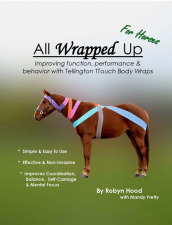
All Wrapped Up: Improving function, performance & behavior with TTouch® Body Wraps (Horse)
Everything you always wanted to know about Body Wraps for Horses.
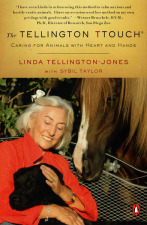
The Tellington TTouch®: Caring for Animals With Heart And Hands
2008 edition with a new cover and some edits.
Shop > Horses > Equipment
Shop > Horses > Videos and DVDs
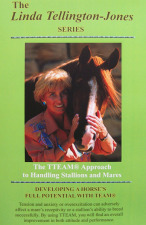
The TTEAM Approach to Handling Stallions and Mares DVD
Tips on handling, breeding and foaling.

Solving Riding Problems From the Ground DVD
Exercises that improve balance, focus, coordination, self-confidence and self-control.
Social Media
Worldwide > Animal Ambassadors International
1991 Green Chimneys
TTEAM News International Vol 11 No 3 Pp.6-7
For three years I have promised Dr. Sam Ross that I would make it to Green Chimneys to share the Animal Ambassadors International® and TTEAM work with his children. Dr. Ross and his wife, Myra, run the most wonderful organization just north of New York City which is a farm school for children with learning and behavioral disabilities who come mostly from the inner cities. They have a really large staff and about 130 acres on the farm that I visited plus other homes for adults.
This visit was organized thanks to TTEAM practitioner Marnie Reeder who met Myra Ross at the Delta Society co-sponsored Human/Animal Bond Conference in Saskatchewan this May. Since I was teaching the advanced training in Wyoming, I asked Marnie to represent Animal Ambassadors International®, which she did and really connected with Myra at the conference. Marnie had originally planned to come with me but at the last minute could not make it.
I began by working with about seventy children between the ages of seven and sixteen with their teachers out on the lawn. I first worked with a fifteen year old Scotty dog of Dr. Ross’s who is somehow managing to hang on in his little body. He looks almost as though someone winds him up in the morning and he stiffly goes on his rounds of inspection of all the children. I worked on his ears and did little python lifts on his legs which are quite stiff and arthritic and showed the children how they could gently work on him. Later I saw three of the children sitting very quietly with him doing tiny Raccoon circles all over his little body.
I also worked on their miniature pony foal up on a picnic table and asked if there were any volunteers among the children who would like to experience the various TTouches as I used them on the animals. We had a number of brave boys and girls who volunteered. Then we brought out two of the horses so that about ten children at a time could come up and practice the Clouded Leopard and Lick of the Cow's Tongue TTouches. Of course there were several breaks during the morning period because I kept sessions short, but we finished the morning by having the children in small groups with their teachers in a circle practicing the Tarantula's Pulling the Plow and the Lick of the Cow's Tongue on each other. At lunch time in the community dining room a nine-year-old boy came dashing up to me and without a word reached out with a big smile on his face and did a quick circle on my arm and dashed off.
In the afternoon I worked with Dr. Ross' favorite horse who was the terror of the therapeutic riding program. He is a very strong bodied and strong minded Haflinger who had the unpleasant habit of simply taking his head away from the volunteer and marching off in the direction that interested him. He was not exactly cooperative in the riding program. I demonstrated the Elegant Elephant and some of the other ground exercises with him and then later rode him in the balance rein. He was completely different. The next day several of the children came to me and told me how proud they were that they had been able to lead him with the wand and chain without him dragging them around and he seemed very cooperative and happy.
Several Vietnamese pot-bellied pigs reside at Green Chimneys. Due to lack of time they had not been handled and consistently squealed and screamed when approached to be moved from place to place. By working them with the wands from about a three foot distance I was able to quiet them and keep a contact. I am looking forward to hearing how their instructors manage to carry on with the pigs.
Another highlight of my visit was working with three young nine year old boys with a Scotch Highland yearling heifer, who is supposed to be show able but couldn't be led. She was described by the boys as being mean and wild. I first observed them working with her and then showed them how to quietly do the circles on her head and her horns and up and down her legs. When we went to lead her which I was told was impossible, I discovered that the calf halter they had on her was really uncomfortable. They had a chain under her chin and when she would pull it would hurt her and the halter would twist around and dig into her. I tied the halter under the chin with some twine and put the chain over the nose as we usually do with the horse and attached a second rope on the other side. Between the wands and the Homing Pigeon position we were able to lead her in and out several times without difficulty.
The boys were really pleased and empowered by their success and by the fact that the heifer was no longer afraid. I love the picture of the one little boy stroking her legs with the two wands. Normally she kicked and wouldn't allow them to touch her legs.
Martha Jordan, Sally Morgan and Carly Buckley came to observe and assist with the children. Martha got some really nice shots of the interaction. I had another small therapeutic riding group with four adolescent boys, one of whom does not like the pony he rides because she attempts to bite him on the foot every time he is in the saddle. I had the children work on her body and on her face and ears. For the first time she did not put her ears back and attempt to bite him when he rode her.
NOTE: TTEAM is an acronym of "Tellington TTouch Equine Awareness Method." Since this article was written, Linda decided to use a brand name for all the facets of the TTouch organization. Currently, that is Tellington TTouch® Training.
1988 A Phone Call from Moscow
TTEAM News International August, 1988 Vol 8 No 3 Pp. 1-2
An Animal Ambassador® connection made the front page news in Meridian, Idaho. In the last newsletter I reported that I had sent 30 letters from the school children to whom Ann Finley had taught an Animal Ambassador week-long program. The letters went to Moscow with Nancy Grahame, Assistant Director of the Institute for Soviet/American Relations, to be given to three different groups with whom I have worked in Moscow.
The problem was, however, that no answers to the letters could be sent back to the US before the end of the school year the last week of May. The Idaho children were excited about a connection with the Russians but many of them thought it improbable that they would hear anything back. Whoever would think it possible to have a Russian connection with a small town in Idaho? Ann felt it was important that we got some acknowledgment for the kids before they finished the school year. She was attending the advanced training program in Oregon with us and there were only four days left before the kids finished school for the summer.
I put on my thinking cap and called Andre Orlov in Moscow. Andre is the Russian free-lance journalist who has spent many hours showing me around Moscow and has assisted me so many times by translating for my TTEAM clinics that he often receives calls for help with horse problems when I'm not there although he has no other connection with horses. He is responsible for introducing me to the Club Healthy Family back in 1985 and interpreted for me the first time I conducted an Animal Ambassador program in Gorky Park. Andre also created the TTEAM logo - the flying horse with a hand for a wing.
Well, I called Andre and asked him if he could meet with the Club Healthy Family, or one of his other school clubs, in time to give them the letters from the Idaho school children and have them draft a telex to the American kids assuring them that their letters and drawings had been received and that replies would be waiting for them in September when they returned to school.
Andre said he would go one better. That he would meet with a group of children - tell them about the Animal Ambassador program and give them the letters and then telephone the Idaho class the day before school ended. We only had to set up an agreed upon time for them to receive his phone call. Ann called the Idaho school and we agreed upon 10:30 A.M., which was 8:30 P.M. in Moscow. The Idaho teachers were warned that it could take some time to get through by telephone, particularly since it was the week before the Soviet/American summit meeting with Reagan and Gorbechav in Moscow.
Ann and I were waiting on pins and needles on Thursday morning. Sure enough the call came through, and everyone in the whole school heard a 30 minute conversation with a Russian talking to several of the teachers and kids. The local phone company had wired all the classrooms so the kids could hear the conversation over loudspeakers. The local TV station televised the kids waiting excitedly for 45 minutes since the phone lines between the US and the USSR were so blocked with summit business.
The call was a great success and was reported on the front page of the local paper next to the summit news. It was great for me too, because when Ann started teaching the program in Idaho she felt great about the results of teaching the kids the TTEAM work but couldn't see how the Soviet/American exchange could ever work. It was too much of a dream. I had no idea when this phase would materialize but I just kept trusting that when the time was right it would. The following is a letter which Nancy Grahame brought back with her and translated for us.
To Adam Nimmo 1327 W. Carlton Meridian, Id. 83642
My dear friend Adam,
My came is Anya. I live in Moscow. I was very happy when I received your letter. I don't know English yet, so my papa translated your letter for me. I am very interested to find out about your life. I think that it will be interesting for you to learn about me. I am eight years old. I study in school. I finished second grade and can now read and write, and I am going into the third grade. What grade are you in? Like you, I also love animals very much. We don't have any pets at home yet, but mama and papa promised to buy me a kitten or a puppy. But I would also like to have a parrot. I love to draw, and in the fall will start attending art school. We are part of the "Healthy Family" club. In the winter we swim in an ice hole in the river, but in the summer just in the river. We go to the public steam baths and to the swimming pool.
Write me about yourself. I'll be waiting for your letter.
All the best! Anya
This letter is for me another step in the realization of the Animal Ambassador vision to connect children, and adults, from various countries for a better understanding between us, with the animals as a focal point.
I've had many school teachers, and TTEAM people, wanting to know bow they can teach the Animal Ambassador program in their schools. We're working on a brochure and I intend to eventually make a video. Patience, patience! The Animal Ambassador vision has been unfolding for years and has had its own rhythm since I got the first piece of the puzzle in 1969. It's fascinating to see how the parts manifest.
NOTE: TTEAM is an acronym of "Tellington TTouch Equine Awareness Method." Since this article was written, Linda decided to use a brand name for all the facets of the TTouch organization. Currently, that is Tellington TTouch® Training.
1987 Animal Ambassadors International Introduced to Elementary School Children
TTEAM News International December, 1987 Vol 7 No 5 Pp. 5-6
I want to share some of my experiences of the last few weeks: introducing TTEAM to elementary school children. So far I've given four presentations - ranging in length from one hour to a week - to students in Grades 1 through 6. Forty-four children have earned Animal Ambassador Certificates. An additional estimated 200 have had hands-on experience doing Raccoon or Clouded Leopard circles on a horse.
Animal Ambassadors International® and TTEAM® were presented to the teachers as ends in themselves and as vehicles for learning empowerment. I wanted to demonstrate that TTEAM can be more than just an interesting sidelight to a school program. It can be a valuable adjunct to the program itself.
To that end the two week-long units that we did were by far the most productive. They gave us time to set specific goals and objectives that addressed both cognitive and effective modes. For example, last week I worked with Celeste Klmerico, who has charge of her school's Gifted-and-Talented and Remedial program. One of the really exciting things Celeste wanted to do was bring these two groups of kids together in a week-long Animal Ambassador unit. One purpose for doing this was to raise the prestige and confidence of the remedial group, to make it easier for them to leave their classrooms each day for "Special Ed." Meanwhile the kids at the other end of the spectrum would be gaining practice in sharing their skills and being supportive while everyone broadened their knowledge of animals and natural history through TTEAM and an imaginative search for a special animal to befriend, protect and learn more about.
Although with each program I realize how much I have to learn. I'm excited about the programs we are doing right now as well as possibilities and plans for the future. Out of the two week-long units a workable, flexible framework has evolved that include the following components.
- Introduction to TTEAM, Animal Ambassadors International and the stuffed toy animals on which they will learn and practice the Tellington TTouch.
- Live animal demonstration with Tehya, a horse, and Bud, a dog – both gentle, beautiful animals who are Ambassadors to the children from the whole vast Animal Kingdom.
- An imaginary, guided tour with Linda aboard a winged horse throughout the animal habitats of the world, looking for a special animal to befriend and protect.
This journey begins at Monkey Mia, in Australia, swimming with dolphins. The children loved making the sound of dolphin-breathing. They journey to the California coast, where sea otters spend almost their entire lives in the surf, rocking to the music of the waves.
On the beach they meet the winged horse, first as a toy animal with wings shaped like hands; with their TTouch it becomes the magical, gentle horse who carries them to Africa, to Australia and eventually back to North America.
The drawings from my coloring book are used to give framework and focus to the imagery. Last week I ended the journey with a recording of wolf howls.
Then everyone rises from their chairs and joins hands in a Friendship Circle while they choose an animal to befriend and protect.
- Back to the left-brain mode. Over-night I have drawn a picture of each child's animal. This is not as difficult as it may sound because many children choose the same animal. Last week we had four eagles. The children use library books to research their animal's color, plus several interesting facts about the animal, which they will write down. They'll also color the animal.
- Children who complete the research may wish to write a poem about or for their animal.
- Validation: Children read their presentations before their classmates and are awarded their Certificates.
It is necessary to remember that this program must be flexible in order to meet the needs of the children with a wide range of abilities. For example, last week we had a gifted first grader, at least one hyperactive older child who usually can best be reached only on a one-to-one basis and a gifted eighth grader who chose to design her own project based on the TTEAM newsletter.
In evaluating the children's responses it is important to point out that most of the children we've worked with so far have been in remedial programs. The hyperactive children are tremendously exciting and challenging. They'll wear you out, but when a hyperactive child sits still for an hour - working on his project - you know your program has got to have some strength.
I have spent a lot of time thinking about ways in which a TTEAM-Animal Ambassador program, with additional components of art and guided imagery, can be used in a whole-brain learning approach. A lot of credit must be given to teachers and teachers' aids, who know how to make the most of a program like this. I have learned so such from the teachers!
Every program we've done so far has served as a springboard for further activity, some initiated by the children themselves. Anne Gahley's remedial classes began asking for more animal books to read, an indication that we provided incentive to nonreaders. One child elected to redo her project. Ms. McCathryn's 'Introduction to TTEAM' was the start of a month-long Animal Unit for Second Graders. Dorabeth Adams plans to use our poetry writing venture as a start to help the children develop vocabulary and imagination in creative writing. Some of Celeste Almerico's students may bring their pets to school to give a TTEAM demonstration for the other children. Her 8th grade is working on a special project to send to Linda.
I believe the program is powered, to a great extent, by the live animal demonstration. The children appear to be positively affected by the presence of the horse. Perhaps they are awed by the horse's size. They press close to the rails of the portable corral, watching the TTouch being done on the horse. They are quick to notice the horse's every reaction. When their turn comes to enter the corral, one at a time, their eyes are shining with pride and anticipation. I am amazed and delighted at how much they have learned working with the stuffed toy animals, and at how well they remember the names of the different TTouches.
When they got to the dog there is sudden laughter. They have invented a new name: Lick of the Dog's Tongue.
I would like to conclude with a poem written by an eight year old girl on behalf of' her animal, the elephant.
Freedom
Is a gray elephant
Eating in the jungle.
Happiness
is a burnt umber elephant
With her calf in the rain forest.
Sadness
Is a brown elephant
Asleep In the zoo.
NOTE: TTEAM is an acronym of "Tellington TTouch Equine Awareness Method." Since this article was written, Linda decided to use a brand name for all the facets of the TTouch organization. Currently, that is Tellington TTouch® Training.
2004 Visit to the Oakland Zoo Goat Rangers and Giraffes
In October, 2004 I joined Practitioner Jaynellen Kovacevich and her Oakland Zoo "Goat Rangers" for a presentation to the youth and their parents. Jaynellen's program won the Oakland Zoo "Volunteer of the Year" award for 2003.
Jaynellen arranged this presentation and potluck lunch with me as a reward for the Goat Rangers.
Their parents were invited to spend the day at the zoo with their rangers, the youngest volunteers at the zoo, to learn more about the program and the benefits of TTouch. This was also an opportunity for the parents to hear about the special contribution the Goat Rangers have made to the zoo and to show pride in them for their accomplishments.
It was especially wonderful to have this chance to honor the work of Jaynellen. She is both a Companion Animal and a TTEAM Practitioner in addition to being a special education teacher. Jaynellen has been teaching TTouch in her school classes for almost 20 years, since the beginning of the Animal Ambassador program.
I talked about the history of Animal Ambassadors International® and how I was inspired with the idea of Animal Ambassadors International from my work in Russia with children and animals beginning in 1985. That was the year that I organized a telephone exchange between a school in Moscow and a school in Utah. In both schools the kids could hear each other (through the interpreters) over loudspeakers that could be heard ri all the classrooms. How rewarding it is to see this concept of animals being our ambassadors for promoting understanding between people and animals these 19 years later.
I presented the Goat Rangers with Animal Ambassador certificates that state, "I hereby vow to use my hands, my heart and my voice to speak for and protect all . . . . . (This space is then filled in with the name of the animal or animals the recipient chose. Many of the youth wrote in "all animals.”)
After lunch we spent an hour with the goats and sheep in the petting zoo, where the rangers introduced me to their favorites, including Pygmy goats, an Alpine, a Nubian, a La Mancha goat and a flock of Barbados sheep. It was exciting and impressive to watch the Goat Rangers as they TTouched several of the senior goats who are being treated by the zoo veterinary staff and zookeepers for arthritis. Educational staff members and keepers have noted that the Goat Ranger program and TTouch have been beneficial to these older goats as well as the other goats and sheep.
Jaynellen has been teaching this class twice a month for almost four years at the Oakland Zoo and has shared the benefits of TTouch with many educational staff members, zookeepers and docents. When she began the program, many of the sheep and goats shied away from being touched. They were used to the public feeding them, but often they were approached by young children pulling on their horns, face or legs. In return, the goats often tried to escape by butting the children. Sometimes parents pushed or hit the goats and sheep to keep them away when they were aggressive about getting food. Not exactly ideal for a petting zoo.
Jaynellen taught her Rangers how to teach visiting children to quietly and respectfully groom the goats and sheep with a soft brush and to do some TTouches on them. Every two weeks for the past four years the Goat Rangers have been handling the goats and sheep in this way.
I just could not get over how gentle and relaxed the animals are. Normally one has to be careful around goats with horns because they can make abrupt moves with their heads and hurt you unintentionally. These goats are so quiet and careful with their heads and will lie still for ages to be groomed gently and TTouched. This gives visiting children and their parents a new way to be around animals with gentleness and respect.
Jaynellen and Avril Keimey, one of the first Goat Rangers, commented that the behavior of the goats and sheep changed dramatically with the use of TTouch and brushing. Avril had this to say about the program: "I used to go to the Zoo when I was younger, and I was one of those kids who was afraid to go into the petting zoo because there were goats jumping on people. About four years ago, I became a Goat Ranger, and started doing TTouch on the goats and sheep, and showing little kids how to pet them nicely. In the time I've been a Goat Ranger, I have seen a huge improvement in the animals' behavior. They approach people instead of running away. I now see very few kids who are afraid to go up to the goats."
Later in the day, Roland and I were shown video footage of the Goat Rangers teaching visiting kids of all ages, including parents, how to gently brush and TTouch the goats and sheep. It is fascinating and inspiring to watch kids enter the area with rambunctious behavior, and within five minutes be relating quietly to the animals. It's totally intriguing to listen to these young Goat Rangers demonstrate and explain exactly how to gently brush the goats. On the video you see goats lying perfectly still, often with eyes half closed, or sometimes lying flat on their sides, enjoying every minute of the interaction. These Rangers are awesome Animal Ambassadors and articulate, patient teachers.
Gail Ellis, School Programs Manager, The Oakland Zoo, said: "There has been an obvious and dramatic change in the behavior and temperament of both the animals and the youth involved. It has been amazing to see."
The "Goat Rangers" are volunteer kids between the ages of 12 to 17. The youth have to commit to six months of volunteer work to be accepted in the program and Jaynellen puts them through a rigorous interviewing process before they are accepted.
NOTE: TTEAM is an acronym of "Tellington TTouch Equine Awareness Method." Since this article was written, Linda decided to use a brand name for all the facets of the TTouch organization. Currently, that is Tellington TTouch® Training.
1988 TTEAM Gives Children Opportunities
Further Thoughts and Observations about the Opportunities that TTEAM Offers to School Children
TTEAM News International April, 1988 Vol 8 No 2 Pp. 1-6
When I began offering Animal Ambassadors International® educational programs in the schools, I had no idea what to expect. I knew that TTEAM was great for animals. Robyn's files burst with case histories of horses and other animals from all over the world that have been helped through TTEAM & TTouch. I also knew that many of these case histories had been submitted by people who had relatively little experience with TTEAM before they were called upon to use their skills on behalf of some animal in trouble. But these people were mature adults; often they were professionals in some field involving animals. The subtleties of TTEAM would not escape them.
It was different with children. I was confident that hands-on experience with live animals would provide motivation and self-esteem, and I hoped it would be a bridge to right-brain learning. But I was totally unprepared for what was to happen.
"Andy would carry the cat around upside down by the tail. I didn't like it, but I didn't know what to do about it. Then this week I noticed a big change in his attitude. He's more considerate. I'm very pleased."
This comment from Andy's father at an elementary school "Parents Night," after I had been doing a TTEAM-Animal Ambassadors International® educational program that had already run four days of a week-long unit, was one of the first hints I had that TTEAM for children is a two-way street. The benefits flow both ways. The feeling for animals that can come with actually doing the TTouch on a live animal opens up doors for some children. They begin to think in a new way that is more responsive and more caring. Many children have this natural ability within themselves, and it is wonderful to see it awakened in a child.
The key is that it happens without fuss, without preaching. The child just has a new awareness, an added element that changes the way in which he perceives the world. In some children, that is going to make a difference, as it did for Andy.
The first educational programs that I was invited to do were with children in Special Educations. As I understand it, these are children who are considered educable, but they do not learn up to their potential. Emotional and/or physical problems may be holding them back. They may be hyperactive and disruptive. Some are gifted, artistic and imaginative, but unresponsive to the left-brain learning approach favored in most schools. Some Special Ed children score high in I.Q. tests and some don't; but they are all lumped together bottom percentile and an enormous amount of effort is expended in trying to solve their problems.
If I'd had a choice, I probably would have chosen to work with mainstream classrooms or children in the Gifted and Talented programs in preference to Special Ed. However, as it turned out, that probably would have been a mistake. Each child in Special Ed is there because he or she has some kind of a problem - a problem that is considered solvable or the child wouldn't be there. So, working with 40 kids, you are going to have at least 40 problems to deal with, each one different. What an incredible laboratory for TTEAM.
Following are some examples. They are not pretentious enough to be called "Case histories" because teachers do not readily disclose a child's background unless something happens, and then they tell you as little as possible, i.e.. "He's hyperactive. He probably didn't get his pill today." The names have been changed in these examples, and anything else that might identify a particular child, as in Andy's case above. But everything else is real.
I would like to begin with an experiment in poetry writing that we did in one class. This came the day after we did an Introduction to TTEAM (with stuffed toy animals) and an imaginative journey throughout animal habitats looking for a special animal that each child could choose to befriend and protect.
Animals are now used as part of the treatment protocol in a growing number of programs, according to Carolyn Reuben, health editor of the "L.A. Weekly." She cites animals as therapy for abused children, delinquents, women in prison and the elderly. For example, animals helped abused children to relax and talk about their fears.
The last thing we were thinking about in our poetry writing class was therapy. I had read a program Mann Lowenfels does to teach creativity to gifted children and thought it would adapt well to our animal program. Simplified from Lowenfels' program, its objective was to enhance creative writing skills by giving children a simple. formula to produce a poem.
We began this lesson by asking the children if any of them had tried the TTEAM circles they had learned yesterday on their pets at home. Most of them had, and a lively discussion ensued as the children reported different reactions of their pets to the circles. The teacher then used this springboard to introduce the concept of "Feelings". She wrote several different feelings on the chalkboard: happiness, sadness, etc. Then we thought of colors, places and actions that were happy, sad, etc. You put them all together with your chosen animal and you had a poem.
And what poems did we get -- from these children who don't usually give?
Afraid is
an orange cat
In a pumpkin patch
Alone.
This is from a child who was, right then, the subject of a bitter custody fight "with many tears." Within a couple days her mother, with whom the child wanted to be, would lose the battle.
Another child from a troubled home wrote:
Mad is
a brown gorilla
Who is furious
On a volcano top.
A third child who was feared in his neighborhood because he carried a tremendous chip on his shoulder. Yet this child comes from a wonderfully supportive family. He wrote:
Happiness is
A gray wolf
In a den
With her puppies.
I think it might have been an eye-opener to some of the teachers that this child could write such a "peaceful" poem. He was showing a new side of his character, but he as also telling that his home life is okay.
Obviously the kids were projecting their own feelings into the animals that they wrote about. It was a safe way to tell us something about themselves. That may be very important for this group.
I believe now that a TTEAM & TTouch lesson, followed by a lesson in creative writing, may help children express themselves. If something is bothering them. They may choose to express their loneliness or rage in a poem. Children who bristle at the idea of writing a poem are sometimes more willing to do so if the poem is on behalf of their chosen animal. Of course, they can also write stories for their animal, as they do after Alexandra Kurland's presentations. It is possible that the animals, imagery and art all tap the right-brain mode, making for a learning approach that can release stress as well as enhance creativity.
"Animals can be some of our best teachers," Alexandra Kurland tells her audience of school children. "Every time I do a live-animal program, I find a new reason to agree with the truth of this statement. The Tellington TTouch circles that the children do open the door."
For example, a horse must be a huge animal from the point of view of a child who may never have touched a horse before. My mare, Starlite, is actually on the small side, less than 15 hands. She is 26 years old, which means that she does not move around very much. She is very pretty, with dark glowing eyes set wide apart, and a white snip and star on her kindly face. Furthermore, she just loves having TTEAM done on her. At home she has been known to "wait in line" for her turn while I'm working on another horse.
When I take her to a school, I load a portable corral on one side of my stock trailer. Starlite goes into the other aide and Lad, a dog rides in the back of the pickup. The corral is to keep the children out rather than the horse in. Some children are fearless and eager to make contact with the horse. The corral helps teachers keep them in line by setting a boundary. It also frees Starlite's head while I am working.
The children enter the corral one at a time to work on the horse. I demonstrate a particular touch, such as Raccoon circles on the ears, first getting the horse to lower her head. Then a child is invited to come into the corral and do the same thing. Most of the children love it. Their eyes are shining and they try so hard to do the TTouch exactly right. I am usually at Starlite's neck, with my arm under her neck, and I can feel her response to the children's TTouch. It is fascinating, because she seems to feel some children's hands much more than others. She will lower her head into my arm in utmost bliss. None of the children has ever frightened her or made her unhappy. It is just that some seem to reach her more.
I think a horse is the most wonderful animal teacher. Maybe it's the size that commands respect. Perhaps it in because TTEAM was originally developed for horses. The good thing is that even if a child is a little bit afraid, using the TTEAM & TTouch the child has something definite to do rather than just pet the horse and thereby, a different type of learning situation is set up. Usually the fear soon vanishes and the child is elated, with a real sense of accomplishment. Starlite feels that she knows she has given the child that good feeling. Merely petting the horse would not get the same results.
Of course, I give the bolder children a little more challenging circles than I do the shy ones. And herein lies a tale.
Bobbie was good looking, disruptive and proud. He began my day making obscene circles on his stuffed toy animal; his next move was to beat on the kids next to him. He flatly refused to do anything I asked of him and spent his time trying to make the other kids laugh -- at my expense if he could. I felt that this was not hatred but a challenge. There is a difference. I learned that Bobbie was usually taught one-on-one (that is, by himself with no other children present) and that it was only on the occasion of my visit that it was thought he might join the others. I wanted to say, "thanks a lot."
Usually with a week-long program I try to bring the horse on the first or second day. But a snowstorm delayed the live animal presentation until Thursday. By Wednesday, Bobbie was intolerable. I went to bed that night having visions of him jumping on Starlite's back, hurtling the corral and riding off into the sunset.
Actually, the next day he was pretty good. He hung on the corral with the other kids (they were allowed to stand on the first rail), raising his hand and shouting "Me" whenever someone was chosen to enter the corral. I had not worked the inside of a horse's mouth in demonstrations before, partly because Starlite doesn't like it that much, but today I did. I played the piano on her tongue. I could bear the deafening silence behind me, no "Me! Me! Me!" for this one. I did hear Bobbie say, "I'm not gonna do that!" I drew the suspense out as long as I dared and then called, "Bobbie!"
To his credit, he walked into the corral without a word. I let him suffer a moment longer and then asked him if he would like to do "Tarantula Pulling A Plow" on Starlite's back. He never said a word, and I have never seen a more focused kid. And boy, did that tarantula pull that plow! Starlite's neck sank happily into the crook of my arm.
The next day the teacher's aide who had been working with Bobbie popped out of the room, eyes wide. "He sat still for an hour! He even did his work!
Of course this was just one day in the life of this child. And we don't know quite why he was affected in this way. For some thing permanent to happen, a much more imaginative, ongoing program would have to be tried. Actually, Marie Luise van der Sode has done a six-month residential program in Europe at a Youth Farm for troubled teenage girls. She reported that some of the girls who were unpopular on account of being aggressive became easier to get along with (and more popular) after learning TTEAM. The work with the animals had taught them an alternative way of being.
Very few children have been too frightened to touch the horse and the dog. Of more than 200 children, I think only four or perhaps five hung back. One boy, Cody (the only boy who showed apprehension), conquered his fear and did very nice circles on both Starlite and Lad.
At the end of the week, the children spoke of their chosen animals in front of their classmates and other classes, and were awarded with Animal Ambassador certificates. Cody decided he couldn't do this. Cody was part of a group of mixed Special Ed and Gifted-and-Talented. The purpose of putting these two groups together was to raise the prestige and self-esteem of the slower group, to make it easier for them to leave their classrooms each day for Special Ed. Another purpose was to teach the advanced kids to share and care.
Cody agreed to let one of the advanced children read his speech for him while he stood next to the other child, holding a picture of his animal. So the advanced child practiced two speeches. Just as everyone got up to leave the room, Cody said, "I think I can do my own."
The teacher asked, "What do the rest of you kids think? Do you think Cody can do it?"
One of the advanced children started a cheer, and every child in the room took it up: "Go, Cody, Go!
Cody did give his speech, and he didn't do it too badly. As we left the other classroom, I told him, "You were brave."
He grinned one of those tooth-gaped eight-year-old grins. "Yeah, but I liked it a whole lot better being brave with the horse."
These speeches that the kids gave when they received their AAI Certificates were an exciting part of the program. One parent made the trip down to the school twice for her son's five-minute program. It was great that she was a devoted mother to do that for her son, and it also gives an indication of how much this program meant to the children. Non-readers started asking for more animal books to read. One gifted boy elected to memorize his speech, when he could have read it. Then others wanted to memorize. Another child (in Special Ed) elected to redo her project the week after I left. So there were just lots of indications that we were motivating these children.
I've found that dogs have different reasons to teach than horses. For example, Lad, Starlite's ambassador, treats each child as an individual. He'll offer a paw to one, try to lick another's face (just one lick per child), touch another's hand with his nose (one touch). Eddie, a smart, aggressive boy, was determined to make Lad shake hands with him. Before I could stop him he reached out and pumped Lad's paw. Immediately the magic left. Lad didn't exactly turn into a pumpkin, but he lost confidence for a little bit. It was a wonderful opportunity to learn myself and to explain to the children that one big part of communicating with animals is to watch and listen for the signals they give you. Of course this can be a step toward learning how to communicate more sensitively with people.
Incidentally, when I began these programs, I felt that learning care and consideration for animals could be a step toward learning care and consideration for other people. A psychologist pointed out that such was not always the case. Some people who relate well to animals do not always relate well to human beings. The animal in this type of situation are a social crutch.
Frank was a child like that. He had a brilliant mind, four pets at home, and he knew more about some kinds of wild animals than I did. He did a super job with the horse. He was wonderful with Lad. But his teacher said that be was verbally abusive to other children, with sexual connotations.
We tried to provide Frank with an alternative way of being by encouraging him to share his tremendous fund of knowledge of animals in the classroom. Understandably, the other children weren't really crazy about Frank, but by the end of the week he was providing other children with information about the animals they had chosen, and starting some interesting discussions. So in this way the animals he loves could be a bridge rather than a crutch.
When you do TTEAM it is like dropping a pebble in a pond. There is a saying that the ripples will eventually be felt on the farthest star. Lad was a dog I borrowed from a mountain man who was not known for his kindness to dogs. Since I have been using Lad for TTEAM work this man's natural kindness has surfaced. He just had never seen dogs as feeling, hurting beings before. They were curs to be yelled at and cowed into submissive obedience. Now he talks to them.
TTEAM is fascinating because you don't know what the results will be or how far they will carry. Its therapeutic value would be somewhat different that the proven stress-reduction that comes from petting an animal. My personal feeling is that TTEAM provides an ideal whole-brain learning situation. You have much more active, focused communication than when patting an animal because you are asking a great deal more of the animal. The animal is more focused because it doesn't know exactly what will come next. Some horses in particular become quite fascinated. They are so involved and politely interested in what you are doing sometimes it is almost comical.
But while you and the animal are focused, you are also very much aware of your surroundings. You have to be aware when working with a horse. An element of personal safety in involved and a sense of where you are in space is a necessity. Thoughts and movements become more precise and clear with experience.
Experiments have suggested that babies learn beat when they are relaxed, happy and alert. I see no reason to believe that animals don't learn the same way, and human beings of whatever age. TTEAM helps to promote this state where learning can happen.
New Program
This spring I am offering a follow-up program directed toward the intentional aspect of Animal Ambassadors International®. This program takes 1-2 hours. Children are introduced to the culture of a foreign country. They write letters about themselves and their pets, or stories about a favorite any species, to be shared with children in the other country.
Regards, Ann Finley
NOTE: TTEAM is an acronym of "Tellington TTouch Equine Awareness Method." Since this article was written, Linda decided to use a brand name for all the facets of the TTouch organization. Currently, that is Tellington TTouch® Training.
1986 Awarding the First Animal Ambassadors International Certificates to Russian Ambassadors
TTEAM News International December, 1986 Vol 6 No 5 Pp. 3-5
One of the highlights of my October trip to Moscow was awarding the first Animal Ambassadors certificates. In Moscow a translation to Russian had been prepared so I took 100 blank certificates to have them printed in Russian, but the Club Healthy Family thought it would be nicer to receive them in English. Many of the same children who participated in the very first meeting for Animal Ambassadors International® attended the gathering. I had thought I would give certificates to all the children who had chosen their animals to protect, but the club adults felt they should have to earn them and are making a proposal for me to consider on my next trip.
We did agree, however, that two of the children there had earned them and the first certificate was given to the 10 year old boy who had chosen a type of tiny snail to protect. His sister received the second certificate, and interestingly enough had chosen horses as her animal.
I was so pleased to show the certificates to our American Ambassadors in Moscow, Arthur and Donne Hartman, who have followed the unfolding of the concept since the beginning. Ambassador Hartman was very pleased with the name Animal Ambassadors. He chose the fox as his animal (one of my totems, as those of you who have seen my fox ring know) and Donna Hartman chose the bear.
At the meeting I had with the Club Healthy Family one of the adults, who is a teacher, asked some important philosophical questions about animals. "What should a child do if they find a stray or injured animal on the street?" I was reluctant to give an answer without more thought so I answered that it was a question which needed consideration. On Friday afternoon I taped an answer to be translated for their club.
I find it always best for me to answer from a personal base of experience instead of from the theoretical. I often see stray animals on the streets and have no opportunity to take them with me. To turn away and ignore them would be a way of protecting my feelings of helplessness or sorrow, but I do not think that is a good idea. That kind of reaction tends to harden our hearts. I like to take some minutes of my time and sit and visit with them. It may mean momentary pain, but then that is a part of the path to appreciation of joy.
I have been greatly influenced by the philosophy of The Little Prince who advises that it is much better to have a friend and leave him than to never have experienced that connection. Khahil Gibran's chapter on Sorrow and Joy has influenced the past 25 years of my Life. As I remember it, "The self-same well from which your sorrow flows, will also flow your joy." When I read these words during a very challenging time in my life I was exhilarated. "Come on tears," thought I. "The more sorrow I experience, the deeper this well will some day be filled with joy."
I have not been disappointed. Realizing that an experience that may hold sadness can also nurture appreciation of Joy is a gift worth receiving.
The image of a small dog on a cold night in Tblisi, Georgia in the southern part of the USSR, often finds its way into my mind. I saw her huddled up on a piece of newspaper late one night as I was returning by foot to my hotel. I squatted an the deserted, windy street and visited for a long while, gently working on her ears, talking to her and doing the TTouch over her whole body to strengthen our connection and companionship. I wrestled with the possibility of taking her with me somehow, considered the difficulties of getting her veterinary papers through friends in Moscow and realized it was impossible for me to keep her since I am on the road constantly. I mentally flipped through the names of friends who might be willing to adopt a Russian animal ambassador.
The difficulties finally became too obvious and I resigned myself to simply enjoying our camaraderie. I think of her frequently and send her my love through thought-form. I can be as strong a connection as a physical touch, with practice.
NOTE: TTEAM is an acronym of "Tellington TTouch Equine Awareness Method." Since this article was written, Linda decided to use a brand name for all the facets of the TTouch organization. Currently, that is Tellington TTouch® Training.
